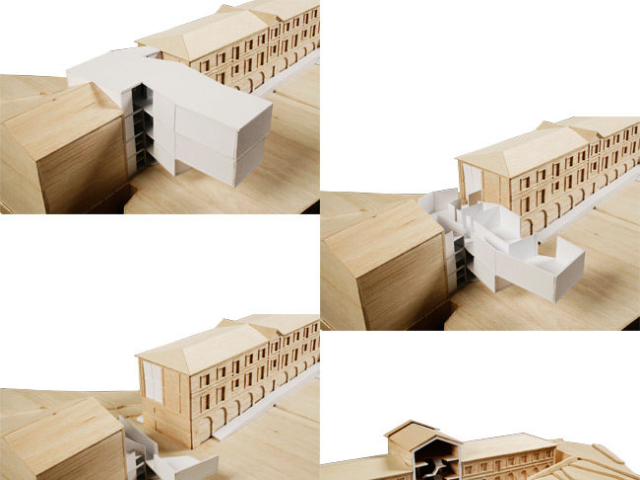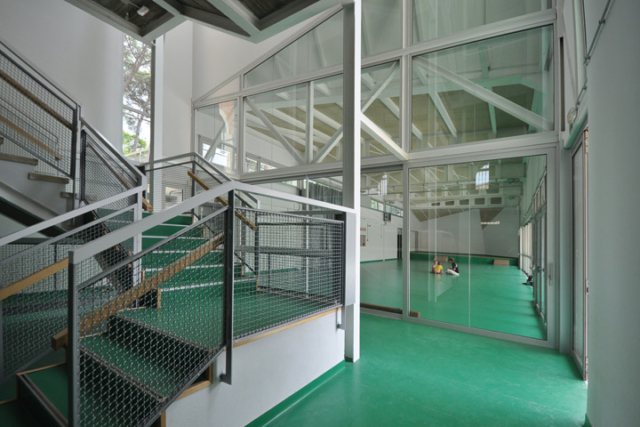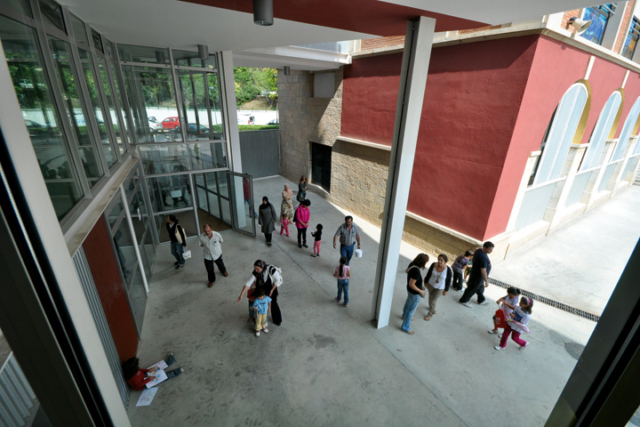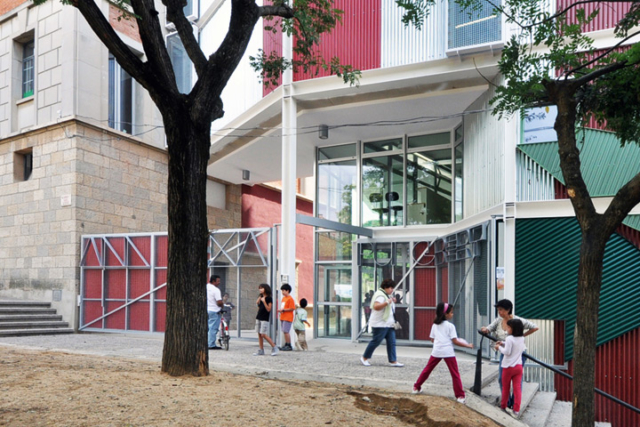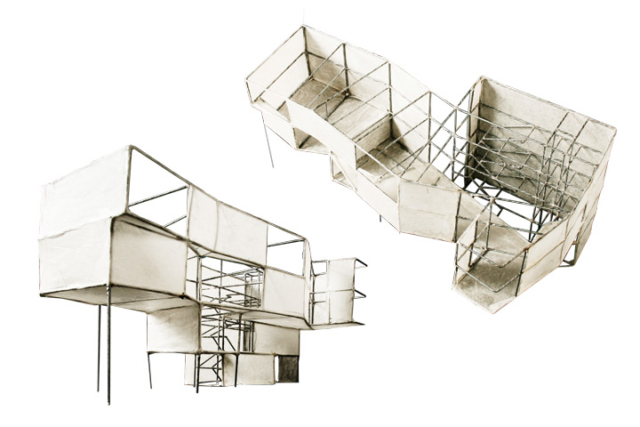Arhitekte:Josep Miàs-MiAS ARCHITECTS
Odgovorni projektant: Adriana Porta
Arhitektura: Silvia Brandi, Josep Puigdemont, Fausto Raposo, Lluis A. Casanovas
Klijent: Javno-obrazovno odeljenje Pokrajinske Vlade Katalonije
Izgrađena površina: 2300 m bruto
Troškovi: 5.000.000 EURA
2007 Konkurs (1.nagrada)
Konstrukcijska faza (početak i završetak radova, mesec, godina)
Početak konstrukcije: jun 2009.
Završetak konstrukcije: septembar 2010.
Annexa-Joan Puigbert je ime škole u obliku slova T koja datira iz pedesetih godina dvadesetog veka. Centralni objekat škole kao i objekat koji se pod pravim uglom nadovezuje na njega, nalaze se u glavnoj ulici. Topografska pozicija objekta je neobična zbog strmog brda na kome je škola izgrađena. Centralni objekat je bio kompletno u upotrebi, međutim ugaoni objekat je bio prilično oštećen, naročito u strukturi.
Odeljenje za obrazovanje Pokrajinske Vlade Katalonije napravilo je program čiji je cilj bio da se poveća broj klasičnih i specijalizovanih učionica. To je značilo izgradnju dodatnog prostora za prostorije poput gimnastičke sale ili kabineta za različite aktivnosti.
Projekat predlaže rušenje objekta postavljenog pod pravim uglom, da bi se dobio kontinuitet spoljašnjeg prostora od borove šume do igrališta u nižoj oblasti. Kabinet za različite aktivnosti je integrisan u uzdužni deo ove topografije. Podudaranje ovog dodatnog prostora na terenu sa glavnim vertikalnim prilazom (unutrašnjim stepenicama) omogućava definisanje vizuelne konekcije između postojećeg objekta, nove gimnastičke sale i igrališta. Stepenice, bez betonskih ploča, nalaze se sa leve strane i povezane su sa novim, vertikalnim prostorom, a istovremeno su povezane i sa višenamenskim kabinetom i igralištem.
Program namenjen formiranju specializovanih učionice predlaže reorganizaciju predloga Odeljenja za obrazovanje: umesto da se ceo neophodan program smesti u nov objekat, u njemu se nalaze samo specijalizovane učionice, dok su klasične učionice smeštene u postojeći objekat koji je renoviran. U novom objektu ima prostora za informatičke učionice, biblioteku, IT i muzičke učionice itd. Ovaj objekat se nadovezuje na susedni zid, a ne na već postojeći objekat sa kojim se spaja u jednoj tački. Novi prostor će biti novi ulaz u Centar, sa stepenicama i liftovima, nezavisan od prirodnog pristupa igralištu. Malo drveće u spoljašnjem prostoru ističe ideju prilaza objektu. Pomeranjem prilaza na ovu tačku olakšana je rutina dolaska i odlaska dece iz škole. Sa druge strane, novi objekat može da funkcioniše nezavisno od ostatka Centra. Zbog toga može da radi i noću ili da se koristi u javne svrhe.
Oba objekta imaju jasan metalni skelet, prekriven industrijskim sistemima i materijalima. Zaista, ova vrsta strukture kombinovana sa prefabrikovanim metalnim panelima (neprozirnim ili prozirnim) čini njegovu izgradnu veoma jednostavnom.
Na neki način, možemo govoriti o dve izvedene operacije. Prva operacija je presecanje postojećeg objekta postavljenog pod pravim uglom, u delu koji je najslabiji (stepenice), i gradnja višenamenskog kabineta. Druga operacija je fizičko povezivanje objekta sa specijalizovanim učionicama sa već postojećim objektom.
Architects:Josep Miàs-MiAS ARCHITECTS
Project leader: Adriana Porta
Architecture: Silvia Brandi, Josep Puigdemont, Fausto Raposo, Lluis A. Casanovas
Client: Public – Education Department Regional Government of Catalonia
Built area: 2300 m bruto
Cost: 5.000.000 EUROS
2007 Competition (1st prize)
Construction phase (beginning and ending month, year)
Beginning of the construction June, 2009
Ending of the construction September, 2010
Annexa-Joan Puigbert is the name of the school that occupies a T-shaped building from the 50s of the 20th century. Its main building lies along the main street, and in the middle point there is another building which is perpendicular. The building’s topographical position is strange, due to the steep hill where the school was built.
The street building was completely in use. However, the perpendicular one was in great deterioration, especially in the structure.
Catalonia Regional Government Education Department’s programme was to increase the number of normal classrooms and specific ones as well. That meant building its correspondent extra space for other activities, such as a gym or a multipurpose room.
The project proposes the demolition of the perpendicular building in order to achieve a complete continuity of the exterior space, from the pine forest in a higher level to the playground in the lowest area. The multipurpose room is integrated in this topography, in its longitudinal section. The coincidence of this added space on the terrain section with the main vertical access (interior stairs) allows to define and to discover a new space of visual connection between the existing building, the new gym and the outdoor playground. The stairs are left hanging, free of the surrounding concrete slabs, and are connected to a new vertical space, linked at the same time with the multipurpose room and the playground.
The special classroom programme suggests reorganising the Education Department’s proposal.
Instead of putting the entire necessary programme in a new building, the existing building is refurbished with only normal classrooms, while the new one has the special ones. In this new building, there is space for technology classes, the library, IT and music classes, etc. It is attached to the neighbour wall, and not to the existing building, in order not to take out its personality. It gets connected to the old building in a single point. The new volume will be the new entrance of the centre, with stairs and lifts, apart from a natural access to the playground. A small tree covered outdoor space enhances the idea of the access. By moving the access to this point, it eases the routine of taking the children to the school and picking them up. On the other hand, this new building can operate independently from the rest of the centre. Thus, it can offer night service or a more general public service.
Both buildings are designed with a clear metallic skeleton. It is covered with industrial systems and materials. Indeed, this type of structure combined with prefabricated metallic panels (opaque or transparent) makes its construction a very agile process.
Somehow, we can talk about surgery in two cases. The first operation is to cut the existing perpendicular building in the most fragile section (the stairs) and to build the multipurpose room volume. The second operation is the physical relationship between the special classroom building and the existing one.





